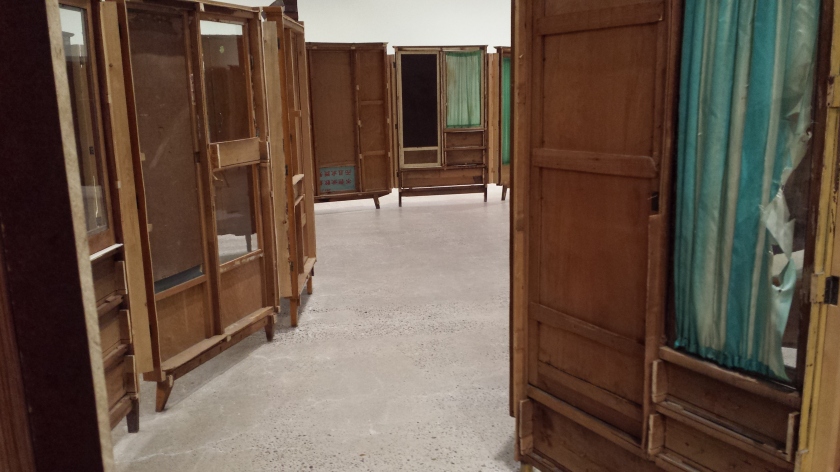Song Dong – Lori Nix
Art Gallery of Ontario – Song Dong
Wisdom of the Poor: Communal Courtyard is the name of the installation by Song Dong at the Art Gallery of Ontario. The piece has the strange effect of slowing down time and creating a consuming sense of melancholy. The viewer steps out of the moment and into a maze, composed of antique wardrobes, and, concurrently, into a bygone era.

Detail of installation by Song Dong
The wardrobes have been dismantled and roughly knocked together to create twisting, labyrinthine passageways. Bits of fabric, modest curtains, broken locks, faded posters and other sentimental items cling to the gutted furniture and add to the sense of forlorn domestic ruin.

Detail of installation by Song Dong
The art piece feels funereal, and there is the lingering presence of ghosts. Glimpses through openings may reveal another viewer wandering hesitantly, an abandoned bicycle or perhaps a rising tower (wait, its the AGO’s Sol Lewitt sculpture and elsewhere is the AGO’s Warhol portrait of Karen Kain.)

Detail of installation by Song Dong
China is famously changing at a breakneck pace despite an increasing public outcry against the demolition of historic neighbourhoods and a gathering preservationist movement. Song Dong taps into a powerful emotional yearning for an idyllic past that is felt apparently all over the world. The object of the loving backward gaze could be the narrow, crowded streets of bygone China or …… Mayberry. In North America this imagery can be baldly manipulative romanticism, covering for a suspect agenda, but what it is in China I do not know.

Mayberry set
Admittedly there are some very appealing aspects to the decades past. For example, long before the rise of Twitter and ISIS (forever linked in my mind) anyone could smoke and drink with abandon, even on airplanes. But is it my actual memories that view these activities fondly or is it the “Mad Men” portrayal of them that I like?

Smoking on airplanes through the eyes of the creator’s of “Mad Men”
Meanwhile the unrestrained development in China has not only resulted in the spectacular buildings we see in the media but some weirdly manufactured nostalgia, for example Thames Town, built to look like a charming Tudor town in the English countryside.

Thames Town, 19 miles from Shanghai
***
Bau-Xi Photo – Lori Nix
All over North America laundromat seating is the same. I may have known this as a fact before I saw the show of photographs by Lori Nix at Bau-Xi Photo, but to be honest I never really thought about it much. In Lori Nix’s photo of a post-apocalyptic laundromat (shown below) under dreadful fluorescent light, the seats are identical to those at the “Coin Wash” in the vicinity of Dundas and Keele. In fact everything is exactly right, except of course the obvious…

Laundromat at Night by Lori Nix
What I liked about looking at these photographs was noticing the detail and how exacting and precise it is. Lori Nix builds miniatures of scenes she comes across in her daily life and then she photographs them. (To learn how she does this click on the link.)
Lori Nix does not replicate reality. In all her photographs something is off, really off. Something has occurred. Things will never be the same.

Fountain by Lori Nix
What’s going on in Fountain, the art work shown above? A spectacular public space has been vandalized and then abandoned entirely. The bronze sculptures have deteriorated, maybe because of chemicals in the atmosphere, such as chlorine, sulfur, nitrogen oxides or maybe just rain. Vines have overtake graffiti and then all (hubris) is silenced by cold and ice.

Bar by Lori Nix
Could this be a bar in rural Ontario on any Sunday morning? It does look very familiar … except there is no hockey memorabilia.
Despite visions of catastrophe Lori Nix’s art work transmits a sense of enthusiasm for the places she creates. With meticulous patience she commits these mundane arenas of everyday life to a suspended state of timelessness.






